We may earn commissions when you buy from links on our site. Why you can trust us.
Samsung QN90B 4K Neo-QLED TV Hands-On
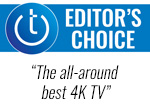 What happens if you take one of the best premium 4K TVs, the Samsung QN90A Neo QLED, and upgrade the video processing from 12 bits to 14 bits? You get the 2022 Samsung QN90B Neo QLED, a TV that is a dead ringer for its predecessor on the outside but offers noticeable improvements in picture processing that translate to visibly better picture quality. Taken together with all of its features and my experience testing TVs for the last nine years, I consider the QN90A the best all-round 4K TV on the market.
What happens if you take one of the best premium 4K TVs, the Samsung QN90A Neo QLED, and upgrade the video processing from 12 bits to 14 bits? You get the 2022 Samsung QN90B Neo QLED, a TV that is a dead ringer for its predecessor on the outside but offers noticeable improvements in picture processing that translate to visibly better picture quality. Taken together with all of its features and my experience testing TVs for the last nine years, I consider the QN90A the best all-round 4K TV on the market.
TV makers have long focused on performance improvements achieved through picture processing. Still, it's only in recent years that algorithms began to strongly compete with hardware advances in terms of impact on the final image. Today's premium LCD TVs have the brightness and color volume needed to make HDR pop, even in a bright room. To use a car analogy, the raw horsepower is there in the hardware, and the software is all about fine-tuning the handling.
When it comes to the wow factor, the QN90B's picture-quality magic is found in the Neo Quantum Processor 4K processor. Its big trick is the coordinated juggling of a wide array of computational tasks, performed with remarkable speed and executed with greater mathematical precision than before. It does this even with HD SDR (standard dynamic range) content, like broadcast, cable, satellite, and streaming services. But, there are visible benefits to 14-bit processing even with the best UHD 4K HDR (high dynamic range) content.
What's new for 2022
14-bit Processing may be new to Samsung's Neo-QLED TVs, but it is familiar to photo and video pros. It's the bit depth commonly used for RAW photo capture in professional DSLR and mirrorless cameras. The key advantage to 14-bit – versus the 12-bit processing and color that it supersedes – is the number of steps used to express gradations in color: There are four times as many per color, 16,384 vs. 4096.
It's important to note that standard HD video is only 8-bit, and HDR video is 10-bit, as is the panel used by the TV. Given these format and hardware limitations, you may wonder how 14-bit processing can make a difference. It's because when you process video, having the extra intermediate steps of 14-bit processing results in a cleaner and more precisely tuned final image.
The use of Mini LEDs, the "Neo" in Neo QLED, allows the FALD (full array local dimming) backlight to isolate areas of high brightness or deep darkness and represent them without distracting artifacts like halos or clouding. But to get the best picture, the panel and the backlight need to work in tandem. Long story short, the extra mathematical headroom of 14-bit processing helps the QN90B's advanced algorithms perform a more intensive optimization before putting a picture on the screen, with visibly better results.
Hands on with the QN90B
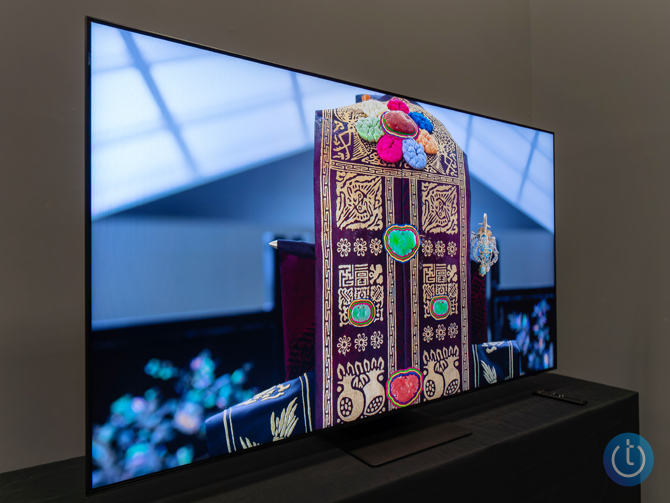
We can talk numbers all day long, but what does this all mean in practice? To find out, I recently spent a day getting hands-on time with a brand-new 2022 65QN90B. I auditioned demo material provided by Samsung and video from my source: An Xbox Series X. One of the first things I did was check the HDMI connection and the modes the Xbox Series X supports. I saw confirmation of 4K HDR, HFR (high frame rate), VRR (variable refresh rate), and ALLM (auto low latency mode). ALLM is especially handy; it puts the TV in Game mode when you play and takes the TV out of that mode when you are watching. This way, you can use Movie mode with cinematic content, even with the Xbox as a source, and not have to think about it.
Samsung showed me some ultra-high-quality 4K clips, with the TV set to its "Vivid" mode, which is the visual experience I'm used to seeing at CES in Las Vegas (but I did not attend this year). It shows what the TV can do if you engage all its processing full-blast and ask it for maximum light output on top of that. It's also akin to what you might see in a showroom, like Best Buy, and it looks surprisingly well balanced despite the pumped-up contrast and color.
Regardless of the picture mode, the upgraded processor results in an overall better picture when judged based on various picture quality parameters, like the smoothness of gradients in deep shadows as the image transitions to black, and even the overall amount of visual pop achieved by this FALD TV when playing HDR content.
For movies, I used Samsung's "Movie" picture mode. Meanwhile, I used the "Game" mode for video games, but with the color temperature switched to "Warm1" instead of the default "Standard," which to my eyes looks the most neutral.
For an immediate, visceral test of motion, detail, and color rendition, I used the Xbox to play Forza Horizon 5, one of the most spectacularly realistic-looking games out for next-generation consoles, and it did not disappoint. The 4K detail, the intensity of the colors, and the overall brightness and contrast – including deep yet detailed shadow regions – showed off the high degree of refinement Samsung has achieved by refining the already excellent 2021 QN90A (check out my review of the QN90A on AVS Forum). It makes the scenery look hyper-real and gives it a sense of depth that fools the eye into perceiving depth.
Testing HDR and brightness
I also checked out various torture-test HDR scenes from the Spears and Munsel UHD Benchmark Ultra HD Blu-ray using the Xbox One X. These scenes are available in 1000-nit, 4000-nit, and 10,000-nit HDR10. 10,000-nit mastering is as rare as unicorns, but more and more, you'll see 4000-nit content in addition to the common 1000-nit mastering. Anyhow, these are scenes that test various aspects of performance, like baby sheep hopping around in the snow, a fierce sunset, a closeup of honey dripping with a pitch-black background, and so on.
The 65QN90B takes the reproduction of these test scenes to a higher level than the QN90A by sorting out the details at the extreme ends of the spectrum – those brightest highlights and deepest shadows just on the verge of absolute black and white – and reproducing them with a smooth perfection that 12-bit processing cannot quite achieve. 1000-nit scenes are rendered perfectly which is a benefit of HDR TVs that can achieve greater than 1000-nit peak luminance, there's no need to tone map. The 4000-nit content also looks great, but I could spot some subtle highlight clipping in scenes with snow.
Neo-QLED is the most advanced LED-lit LCD screen Samsung offers, with around 3X more brightness than OLED. With full-screen white, an OLED might reach 200 or so nits (a measure of screen brightness), while the QN90B can sustain 600 nits. This brightness is needed to overcome the ambient light in a room.
Samsung's Neo-QLED design achieves levels of brightness OLED TVs can only dream about, not only peak brightness but also full screen. This results in excellent picture quality in bright environments, plus there's no risk of burn-in.
Testing dark levels
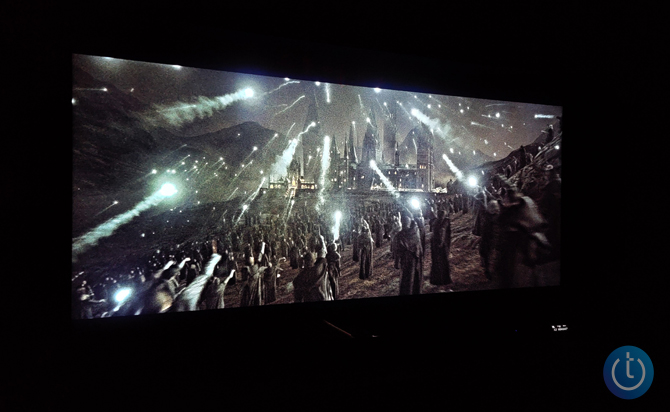
There's a scene in Harry Potter and the Deathly Hallows Part II where Voldemort and his army assemble on a hilltop and attack. It is a bit of a legendary scene among TV reviewers for its ability to trip up the FALD algorithm on TVs, as well as the HDR tone mapping of projectors. It is common to see it represented as dim, or dull, and too dark. Not so the QN90B. Its rendition of the UHD Blu-ray is stunningly detailed and punchy, while preserving the figuratively and literally dark look.
One thing TV makers have really struggled with since the plasma era is handling the very deepest shadows, showing the darkest shades without crushing them, or creating banding and other digital artifacts. The QN90A can't quite get these extremes perfect, but from what I saw with my own eyes, Samsung has fully resolved this issue with the QN90B.
Another impressive way the QN90B handled the Harry Potter scene is when fireballs are launched, a true test of HDR if there ever was one because you have hot white orbs traveling over a deep dark backdrop. Not only did it render the scene with true HDR zip and pop but it kept things well under control in terms of light leaking into the letterbox bars. This is a TV that is not only happy to shine bright as you watch sports in the daytime but also it offers a compelling home theater-quality viewing experience when the lights are out.
Advanced features of the QN90B
This TV has numerous advanced features, shared by other top-tier models like Samsung's 8K neo QLED offerings. In terms of connectivity and features, the QN90B is fundamentally the same as the QN90A, which makes it one of the best TVs for next-generation console gamers. Equipped with HDMI 2.1 and eARC (enhanced audio return channel), it supports 4K up to 120 Hz with VRR (variable refresh rate), for the smoothest next-generation console gameplay.
Another advantage of the 120 Hz panel, it properly plays 24p video, the Hollywood standard for almost a century. Your eyes are so used to 24p cadence any variation of timing comes across as unnatural. While not unique to this model, because 120 is evenly divisible by 24, the TV can reproduce the motion in movies without any judder. By comparison, 60 Hz panels can't show 24p with a natural cadence because 60 divided by 24 is 2.5. Moreover, this TV's quantum-dot color covers the DCI/P3 color spectrum with what Samsung calls 100% Color Volume. DCI/P3 color is used in UHD HDR mastering of most HDR, whether streamed or on disc. Covering this gamut means a vibrant yet accurate color that fully expresses what the director intended you to see.
The QN90B gets Samsung's latest Eco Remote, which is notable for being battery-free and self-charging using solar and RF harvesting. This sleek remote self-charges using the small bit of current that it can harness from radio signals like WiFi, which are now ubiquitous in most homes. So even in a dark room, the remote is likely slowly charging. And if RF plus visible light is not enough to keep the remote perpetually charged, a quick USB fill-up takes care of business. Samsung's goal is to eliminate the need for disposable batteries.
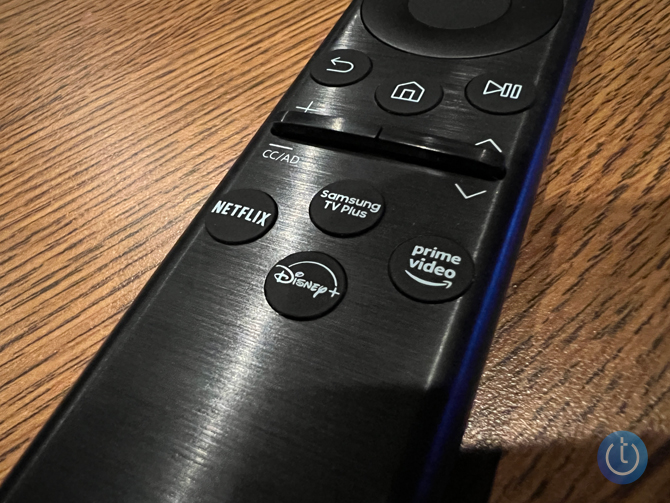
Samsung equips this TV with its latest and greatest smart platform based on its Tizen operating system. There is a wide variety of apps to choose from and you can perform voice searches with the remote to access content if you use the TV apps. For voice search, you can choose from the company's Bixby smart assistant, as well as the usual suspects: Alexa and Google Assistant. Alas, Siri is not invited to this party.
Format support is deep and accommodates streaming from just about any device in just about any format, from photos to 360 video to music to various types of 4K HDR: HDR10, HDR10+, and HLG. It'll even act as an IoT hub with SmartThings support. And when you add up all it can do, the QN90B is a rather smart TV, indeed.
The bottom line
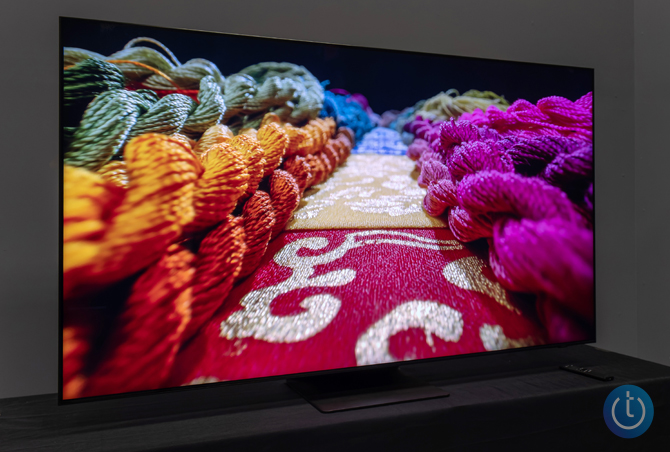
The QN90B is an excellent choice for 4K gaming, video streaming, TV watching, Ultra-HD Blu-ray movie viewing, and even to employ as a giant PC monitor. With its numerous user-friendly features and better-than-ever picture quality, it is arguably the all-around best 4K TV on the market, superseding the QN90A.
The QN90B series has size ranging from 50" up to 85" at launch. You can buy the QN90B 50" for $1,599.99, the 55" for $1699.99, the 65" for $2,499.99, the 75" for $3,499.99, and the 85" for $4999.99.
[Image credit: Samsung, Mark Henninger/Techlicious]
Mark Henninger is an AV enthusiast, equipment reviewer, photographer and videographer. He is a THX-trained video calibrator and has extensive experience working with consumer displays including TVS, projectors, monitors and smartphones. Eight years ago, Mark started the editorial review program at AVS Forum, where he served as Senior Editor and then Editor.
Discussion 
Hmmm
Why virtually all tv manufacturers LIE about their HDMI 2.1 support (except where it meets the full 48gbps bandwidth in which case it is ALWAYS explicitly and prominently stated.
The full “HDMI 2.1” Specification required 48gbps of bandwidth and a long list of features. However, the HDMI ® Licensing Administrator, Inc. Corporation which actually licenses and administers the “SPEC” allows use of the copyrighted “HDMI 2.1” label even if the device does not meet the full specs AS LONG AS THE PORTIONS OF THE SPEC ARE MET ARE INCLUDED IN ALL ADVERTISING AND DESCRIPTIONS OF SAID DEVICE.
This requirement to use the “HDMI 2.1” label is why manufacturers (usually) all include exactly what aspects of the full specification are actually supported. Sadly, they are NOT required to include the amount of bandwidth expressed in gbps nor the total number of ports that met the disclosed supported portions of the HDMI 2.1 spec either.
In order to run 4K even at 60hz with full 10-bit color and 4:4:4: chroma (no compression) necessary for the sharpest image and prevent blurry text you a minimum of 24.1gbps bandwidth.
Generally speaking, the big 3 Samsung, LG and Sony include ALLM, VRR and QMS or QMT etc. Unfortunately, this subset of features translates into just 24gbps…Which is just short of the necessary bandwidth for 60HZ and not nearly enough to run 4K, 120hz w/10-bit (HDR)@ 4:4:4: (30gbps+) let alone met the full 2.1 requirements and features.
HDMI 2.1 is a “legal” way for these corporations to commit what most people consider outright fraud… Lying by omission and obfuscation is still a lie…
Are you saying Samsung QN90B does not support 48Gbps HDMI? Review i have seen say it is full 48Gbps (FRL 12x4). Samsung QN90B us using a new custom MediaTek SoC from what I understand and MediaTek Pentonic 1000 will be in all TVs in 2023 with full 48Gbps.
The smaller size Qn90a did not support the same features as the largest models. Such as 4K 120hz support. Does the new smaller model suffer from the same limitations?















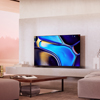
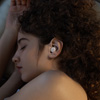
From Bryce Birkman on March 20, 2022 :: 3:35 pm
The QN90A has problems with reflections, particularly if placed opposite windows. Does the QN90B have the same problem
Reply
From rower30 on May 18, 2022 :: 4:32 pm
I have a 75” QN90B, and it does OK with Windows opposite the set. But just OK. The screen seems to be more CLEAR than my Q90T was, which did a little better for reflactions in general.
Same spot for both TV’s. The benefit to the QN90B, is the picture has a DEEPER look to it on most good material.
The “window” is three East facing double pane’s directly opposite the TV so the morniong sun beams right in VERY aggresively. This is a worst of the worst and WHY we got this BRIGHT QN90B set. It works. Ya, we see reflections in DARK sceens on the screen but the picture shines through such that the brain sees the picture and not the reflection unless you look for it.
For a reference, we use the STANDARD picture pre set.
For HDR movies it is really nice. I don’t see any objectionable blooming but my eye seems to suffer from poor contrast over blooming. The QN90B has very good contrast with the ~1000 zone FALD system it uses on the 75” set. I haven’t seen any screen pumping at all so far.
All in all this is a nice TV. Not happy with the REMOTE as it is too CHEAPLY made and terrible to pick-up as it is small and FLAT. The Q90T remote was far, far superior. This remote is so thin, and the side buttons so close to the edge of the remote, you constantly hit them and jump to streaming services. There is nothing good to say about it other than it doesn’t need batteries. Other than that it is worse than the older remote.
Reply